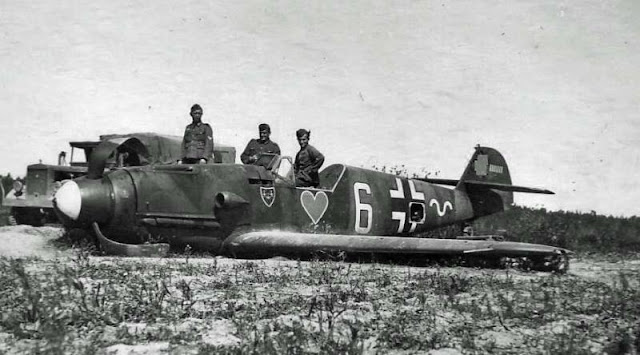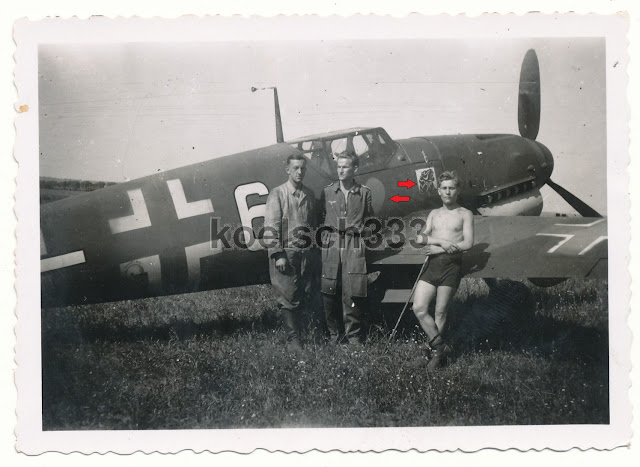Early Emils of I./ JG 76 during the Polenfeldzug - note the 'Lion of Aspern' emblem - I./JG 76 became II./JG 54 in July 1940. An early luminary of I./JG 76 was Hans Phillip who returned his first on 5 September 1939. JG 76 flew operations through the Battle of France and claimed some 69 Allied aircraft downed, with Ltn. Roloff von Aspern (8), Ltn. Hans Philipp and Ofw. Max Stotz (both 7) and Oblt. Dietrich Hrabak (6) the top scorers. Offered via Marco at koelsch333 and sold for 100 euros +
Below; successful pilots of I./JG 76 in Poland and France; unknown, Uffz. Max Stotz, Rudolf Hager, and, below, Ltn Hans Phillip on the accordion..
III./ JG 54 Friedrich
Below; 8./JG 54, Siwerskaja 1942. Friedrich of the Staffelkapitän Oblt.Max-Hellmuth Ostermann, Bf109 F-4 WNr.13088. Note StaKa aerial pennant just visible ( in red?)
Below; crash-landed "black 5" is the Bf 109 G-2 WNr.13803 of Uffz. Arthur Stern from 8./JG 54 who was forced down following Luftkampf on 27 October 1942 near Losibzy. (note the 2 small intakes just over and in front of the exhaust stacks to identify the variant) The machine was reported as 45% damaged. Also a view of the tail of Stern's 'black 5' which displays 11 claims on the rudder. Stern claimed a P-40, his 11th, on 7 October 1942.
Bf 109 G 2 9./JG 54 (Y3+~) Wilhelm Schilling, Krasnogvardeisk 1943. This image has been widely reproduced (and probably 'improved') in a number of publications from Ritger to Prien's JfV. Another view below the colour image of Bf109 G-2 "Yellow 3" of 9./JG 54 flown by then Fw.Wilhelm Schilling (that is, if the seller's caption is correct), and the photo might have been taken sometime before 16 September 1942. On the aforementioned date he was WIA in the vicinity of Dubrowka. The various emblems are - JG 54 Geschwader emblem, III./JG 54 Gruppe emblem and the 9./JG 54 Staffel emblem, albeit slightly oversized, as sported in summer-autumn 1942 period.
Below;
Guines on the Channel coast, sometime in early October 1940. This is "gelbe 1“ flown by Oblt. Hans-Ekkehard Bob of 9./JG 54, featuring yellow engine cowl covers, the emblem of 9./JG 54 ahead of the cockpit and the 'flying clog' of 7./JG 54 on the cowl. A 250 kg bomb is slung under the fuselage on the ETC 500 IX/b rack

Below; neat close-up of the 'huntsman' emblem of 3./ JG 54 as seen on 'Yellow 7' sometime during 1940.
Above and below; the "huntsman" emblem of 3./JG 54 originated in a 19th century childrens book, still popular in the III.Reich, entitled "Der Struwelpeter" but here with the addition of Spitfires in the hunter's swag bag. In the rare image below, it appears on the Bf 109 F "Yellow 1" flown by the Staka 3./JG 54, Hans Schmoller Haldy during "Barbarossa" (Barbas)
flying clog emblem of 7./JG 54
Below; Bf 109 E-3 "White 7" 1./JG 54 the regular Emil of Oblt. and Staffelkapitän Reinhard Seiler, the 'Mickey' evidence of his service in Spain


Messerschmitt Me 109 (mit Kennzahl 7) features the Staffelabzeichen of 8./JG 54 and the emblem of III./JG 54 and an interesting Tarnanstrich (camo scheme). Note also the score on the rudder
below; Bf 109 F-2 WNr.8086 Uffz Alfred Döllefeld "Gelbe 7", 9./JG 54, Eastern Front, Winter 1941-1942
























































